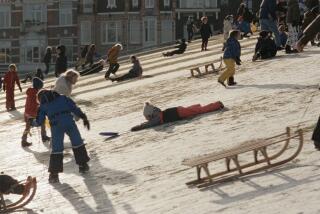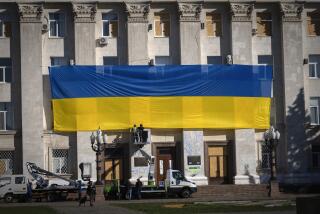40th Anniversary of Allied Attack on ‘Defenseless’ City : Bitterness Over Dresden Raid Remains
- Share via
DRESDEN, East Germany — “Socialism triumphs,” brays a billboard atop an ugly high-rise block on Leningrader Strasse in Dresden, a beautiful baroque city until an Allied firebombing 40 years ago reduced it to smoking ruins.
Today, once-graceful Dresden is a city of Soviet-inspired monoliths from the 1950s. Its residents still recall the horror of the Feb. 13-14, 1945 raid, many as intensely as if had just taken place. Some cry openly when recounting their memories.
“It was like running into hell. The streets were full of flame,” said Gerthold Breitholz, talking to a reporter recently allowed to visit the city by the communist East German government.
The task of rebuilding Dresden was enormous. At least 35,000 people were dead; 250,000 were homeless. The great sandstone churches, palaces and public buildings of the Saxon and Polish King Augustus the Strong were rubble.
City officials and residents express bitterness at the decision to attack Dresden, a civilian center with no military or industrial targets.
“It was war. German Fascists started it. But no one can deny that by February, 1945, the war was won,” Dresden Mayor Gerhard Schill said.
“Dresden had no strategic importance. It was full of refugees and was one of the world’s most celebrated architectural treasures. The raid was barbaric.”
Schill--and many historians today--say the raid was a revenge attack. Nazi forces had raided civilian targets earlier in the war--taking a terrible toll of death and destruction in Warsaw, Rotterdam, London and Coventry in the English Midlands.
Exactly why the raid was mounted and why Dresden was selected remains unclear.
British Prime Minister Winston Churchill in his memoirs said the target was “communications.” But Royal Air Force maps of the target area show the claim was untrue, and the railhead was untouched.
The raid appears to have been the brainchild of the dour, schoolmasterly Sir Arthur Harris, the wartime head of the Royal Air Force who had long advocated civilian bombing to a not unsympathetic Churchill.
“All great wars are always against the whole nation. They are not boxing matches between selected individuals,” said an unrepentant Harris in an interview with West German television before his death last year.
There is evidence the Americans found the raid distasteful but participated because of British insistence.
Whatever the reasons, the raid was devastating.
About 10 p.m. Feb. 13, 800 British bombers began dropping incendiaries and explosives on the defenseless city. The next day, 400 U.S. bombers attacked at noon.
When the skies emptied of the waves of huge aircraft, hundreds of tons of TNT, incendiaries and phosphorous cannisters had been dumped on the 9 square mile city center. The city was an inferno.
Residents recall people sinking into streets turned into boiling asphalt, others running ablaze over mounds of bodies to plunge into the waters of the Elbe, itself coated in a sheet of burning phosphor.
“For hours the streets were filled with helpless sobbing and the horrific screams of death,” wrote Dresdener Walter Weidauer.
The city police chief reported 35,000 people were killed, a figure Western historians believe is low.
Some historians claim the East Germans cling to the 35,000 figure to lessen joint embarrassment with Moscow over the mass of refugees who arrived in the city fleeing the Soviet army’s advance--perhaps as many as 500,000 may have been in Dresden at the time of the raid. Some historians believe refugee deaths went uncounted and estimate the death toll at 100,000 to 130,000 dead.
Schill was clipped and grim on the subject.
“Isn’t 35,000 enough?,” he said when asked.
One of the worst architectural losses was the Semper-Oper, the magnificent 19th-Century baroque-style home of the world-famous Dresden Opera.
The shell of the shattered building, finished by Friedrich Semper in 1850, was shored up after the war with the help of massive public donations, but it was not until 10 years ago that state money was found for the final push to return it to its former glory.
The Opera House is now the centerpiece of the new city that has risen phoenixlike from ashes. In the massively ambitious, splendid project to build an exact replica down to the finest details of gold leaf decoration, lost building techniques such as the method of polishing of plaster to resemble fine marble had to be mastered from scratch.
For East Germany, the new Semper-Oper is not so much the focus of the aspirations of Dresden residents as it is a powerful symbol of the painful post-World War II reconstruction by state socialism
More to Read
Sign up for Essential California
The most important California stories and recommendations in your inbox every morning.
You may occasionally receive promotional content from the Los Angeles Times.













